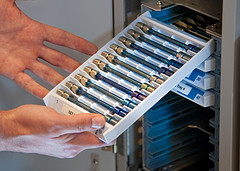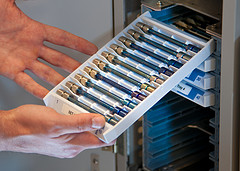Scientific Information of Molybdenum in Chemistry

Molybdenite has been located and mined in China, the Russian States, Chile, Canada, Peru, and in the United States near the continental divide. The mines may yield different products or combinations of products: molybdenum only in primary sources, copper ores in by-product sources, and both molybdenum and copper in co-product sources. Molybdenum mining prospectors drill into proposed exploration sites and extract core samples every few thousand feet (1000 ft = about 305 m). These cylindrical samples are removed from hundreds of feet (100 ft = about 30.5 m) into the bedrock.
The process of molybdenum mining depends on the laws in the locations within the country where veins of ore have been discovered. If the ore is found deep, subsurface mines are dug. If it is on the surface or at a shallow depth, surface mining techniques are employed. The U.S. Environmental Protection Agency is a good source for information about the strip mining of molybdenum. When a discovery of ore is made in the United States near the surface, the procedure for molybdenum mining is as follows: clear the site of brush and topsoil, remove the ore, and restore the location to its former appearance.
Molybdenum, also referred to as moly, is element 42 on the periodic table of elements, a chart that lists the different types of atoms that exist and the characteristics that each possesses. Molybdenum ore, or molybdenite, is slippery to the touch and leaves a black mark when moved across a light surface. It was originally mistaken by many for lead. In 1781, Peter Jacob Hjelm isolated molybdenum as a pure element, belonging to the same chemical family as chrome and tungsten, elements known for strength and heat tolerance.
The first step in strip mining for molybdenum is using a dragline excavator. Thousands of tons in weight, the excavator looks like a giant moving crane with a bucket attached to the end of its boom. With the use of ropes and pulleys, the bucket is dragged along the ground picking up plants, topsoil, and eventually the bedrock. Once all ore has been retrieved, the excavator moves to a new location and repeats the process.cement making plant:http://www.hxjq-crusher.com/
limestone dryer:http://www.hxjq-crusher.com/21.html
Molybdenum disulfide is changed to molybdenum oxide by heating it in air. The sulfur is removed as sulfur dioxide gas. Though molybdenum oxide is usually the export product from molybdenum mining, it can be changed into molybdenum by heating it in the presence of hydrogen gas. The oxygen, within the molybdenum oxide, bonds with the hydrogen to form a solution of water and pure molybdenum atoms.
After the ore has been removed by the excavator bucket, it is dumped into nearby, large-diameter, hollowed-out wells. High-pressure water is forced over the ore to form a slurry of rock that is suctioned off by 2-foot (60.96 cm) diameter pipes and sent to the mill for processing. Chunks of bedrock removed from the site, on the way to the mill, may be as large as 9 inches (22.86 cm) in diameter.
The next process is benefication, in which the rocks are ground down, and then separated into ores and waste products. Benefication consists of three parts: washing, separation by density to remove magnesium oxides, and flotation. The ore debris is put through repeated cycles of rinsing, crushing with ball mills, and sizing through screens, until a concentrated batch is produced, which is made up mostly of molybdenite ore in the form of molybdenum disulfide. Molybdenite is the only molybdenum ore that separates readily through the floatation process, possibly because of how, as a fine particle, it repels, or is repelled by water molecules.
The article is provided by Henan Hongxing,which is the professional manufacturer of complete sets of mining machinery, for example,cement rotary kiln, it is always doing the best in products and service.
Molybdenite has been located and mined in China, the Russian States, Chile, Canada, Peru, and in the United States near the continental divide. The mines may yield different products or combinations of products: molybdenum only in primary sources, copper ores in by-product sources, and both molybdenum and copper in co-product sources. Molybdenum mining prospectors drill into proposed exploration sites and extract core samples every few thousand feet (1000 ft = about 305 m). These cylindrical samples are removed from hundreds of feet (100 ft = about 30.5 m) into the bedrock.
[youtube http://www.youtube.com/watch?v=lXh8bnqMOZs&fs=1&rel=0]
It’s a simple claim made on thousands of personal care products for adults and kids: hypoallergenic. But what does that actually mean? Turns out, it can mean whatever manufacturers want it…
Related Chemistry Articles
